Introduction
Complementary foods are required for infants aged 6-24 months. Complementary feeding will affect the growth and development of under-five children. Thus, the products for complementary feeding that meet the Recommended Dietary Allowances (RDAs) are needed at that age range. The complementary/supplementary foods to be given must contain carbohydrates and protein that meet the RDAs. The food product developed for complementary/supplementary feeding was in the form of instant porridge, with consideration of its relatively long shelf life, more practical due to reduced volume, easy to serve, and relatively easy to handle in the distribution process.
The carbohydrate source for the complementary food was modified cassava flour (mocaf). The functional characteristics of cassava flour can be improved by processing it into mocaf, which can be made by fermentation using lactic acid bacteria and the autoclaving-cooling cycles (ACC) method.1,2 Skim milk and tempeh flour as protein sources were then fortified with micronutrient premix (Fe, Zn, vitamin B1, vitamin B2, and folic acid) and also enriched with inulin. The administration of inulin as a prebiotic could help increase calcium absorption.3 Foods that have the physiological activity to increase calcium absorption are needed to improve calcium absorption.4 The previous study has identified the food components and food composition that can positively affect calcium absorption.5 Based on the description, inulin-enriched instant porridge is expected to play a role in increasing calcium absorption in infants aged 6-24 months.
This study’s research objectives were: (1) to assess the organoleptic characteristics of inulin-enriched instant porridge in relation to physical, chemical and micro-biological properties and responses; (2) to analyze the effectiveness of the instant porridge developed and aimed at increasing calcium absorption and deposition in the femur of protein-malnourished (PM) and protein-energy malnourished (PEM) infant rats.
Materials and Methods
The materials and tools used
The raw and supporting ingredients used in the current study were modified cassava flour, tempeh flour, skim milk, inulin, icing sugar, palm oil, micronutrient premix (a mixture of Fe, Zn, vitamin B1, vitamin B2, and folic acid), vanilla flavor, and water. The chemicals for analysis, the materials for microbiological analysis (Plate Count Agar medium, deMann Rogosa Sharpe Agar medium, and starter of Bifidobacterium longum atcc.), materials for effectiveness testing, consisted of Sprague-Dawley albino rats, ration ingredients (corn starch, casein, mineral mix, vitamins, and corn oil).
The tools used in the current study were a digital balance, cabinet dryer, steam jacket kettle, blender, disc mil, vibrator screen (mesh 40), drum dryer, and sealer. The tools used for physicochemical analysis, microbiological analysis, the tools for effectiveness testing include: Scanning Electron Microscopy (SEM) JEOL JSM IT 300 from Japan, and Energy Dispersive X-ray Analysis (EDXA).
Instant porridge formulation
The formulation of instant porridge for complementary food can be shown in Table 1.
Table 1: The formulation of instant porridge for complementary food.
| Materials | Formulations | ||
| F1 | F2 | F3 | |
| Modified cassava flour (g) | 450 | 450 | 450 |
| Tempeh flour (g) | 143.95 | 95.975 | 48 |
| Skim milk (g) | 48 | 95.975 | 143.95 |
| Inulin (g) | 8 | 8 | 8 |
| Micronutrient premix (g) | 0.15 | 0.15 | 0.15 |
| Icing sugar (g) | 250 | 250 | 250 |
| Palm oil (g) | 100 | 100 | 100 |
| Vanila flavor (g) | 0.05 | 0.05 | 0.05 |
| Total (g) | 1000 | 1000 | 1000 |
Note : F1 = tempeh flour:skim milk (75:25), F2 = tempeh flour:skim milk (50:50),
F3 = tempeh flour:skim milk (25:75)
The instant porridge was made by mixing all raw and supporting ingredients. The pregelatinization was then performed using a steam jacket kettle; i.e., heating and stirring the mixture and cooking water with a ratio of (1:2) at 370C-400C. The paste of the baby porridge that had been cooked was dried using a drum dryer at 1200C-1400C, a pressure of 2.7 kgf/cm2, and a rotational speed of two rpm. The milling or flour production was then carried out using a disc mill. The next stage was to homogenize the size using a 40 mesh screen vibrator. The final stage was weighing and packaging using modified method from Tampubolon et al.,6
The treatment given to the selected formula was the ratio of ingredients to cooking water as follows: A1 (1:2), A2 (1:3), and A3 (1:4). Besides that, the formula was also treated with different pregelatinization time as follows: B1 (two minutes), B2 (four minutes), and B3 (six minutes). The treatments used a 3×3 factorial design experimental model and completely randomized design (CRD) with three replications.
Analysis of physical, chemical, microbiological, and organoleptic properties
The development of the product formula was performed by physical, chemical, and microbiological analyses and evaluation of organoleptic quality as a test of the product acceptability. The analysis of physical properties included rehydration capability, solubility, and surface morphology form by Scanning Electron Microscopy.7–9 The analysis of chemical properties of the protein content used the Kjeldahl method (SNI 01-2891-1992),10 and the microbiological analysis was performed using the total plate count (cfu/g).
The organoleptic test on color brightness, aroma, sweetness, viscosity, and smoothness in the mouth that used a hedonic test based on the method of Soekarto and Hubeis,11 was conducted on 30 mothers of infants aged 6-24 months because the mother was the dominant determinant of the infant’s diet with hedonic scale 1 to 6.11 The formulas selected from the results of the hedonic test that used the infants’ mothers as the panelists were then tested on 30 infants as the next panelists. The inclusion criteria for the panelists were infants aged 6-24 months, in a healthy condition, had consumed and accepted the porridge (in terms of preference), not having gastrointestinal disorders, and their mothers were willing to have their infants included in the sensory evaluation. The exclusion criteria were sick infants, including those with digestive disorders, mouth sores, and toothaches or those refusing the porridge during the test. Before the test, the panelist’s mothers were briefed on how to assess the infant’s porridge acceptance level. The preference level was assessed by observing facial expressions based on Guinard’s method and whether there was porridge spit out by the infants after eating two or three mouthfuls of porridge.11 The scale of the facial expression is presented in Figure 1 below.
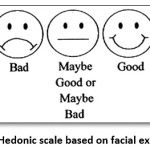 |
Figure 1: Hedonic scale based on facial expression12 Click here to View figure |
The best instant porridge was chosen by the scoring index method on the results of physical, chemical, microbiological, and organoleptic analyses. The results of the analyses were then compared with the Indonesian National Standards Number 01-7111.1-2005 regarding Complementary Foods in the Form of Instant Powder.
The data processing and analyses used 2007 Microsoft Excel program and SPSS version 21. The data were presented as mean. The ANOVA and post hoc test (Duncan’s multiple range test) were performed to determine the differences in treatments, and the p-value less than 0.05 was used as the cut-off for significance.
Product Effectiveness Test
The product effectiveness test had obtained ethical approval from the Institutional Animal Care and Use Committee of IPB University with number 140-2019 IPB. This stage aimed to determine the effect of the administration of modified cassava flour-based instant porridge fortified with micronutrient premix and enriched with inulin on the effectiveness of calcium absorption. The first stage was the development of malnourished rat models by giving low-protein diet and low energy-protein diet for 30 days. The second stage was intervention, namely feeding the rats with diet made from mocaf-based instant porridge products fortified with micronutrient premix and enriched with inulin for 30 days. The type of albino rats used was from Sprague-Dawley strain. A total of 15 male rats aged 21-28 days with a weight of 50-100 g were used in this study. They were housed individually in stainless steel cages under 12-h light/dark cycles, at controlled room temperature (± 220C) and humidity (50%-60%).
The treatments in this study used two kinds of daily diet that were adjusted to the rat groups.The normal control (C) group used a standard diet in the form of AOAC (2005) diet.13 The modified AOAC diet was given to the group receiving a protein-deficient treatment (PM group) with protein content in the diet of 5% of the total daily energy.14 The food restriction method was used to develop malnourished rats in the protein-energy malnourished (PEM) rat group. The diet given to PEM group was limited to the amount consumed ad libitum by the normal control group.The malnourished rats were conditioned for 30 days then followed by intervention with mocaf-based instant porridge for another 30 days. All of the diet was given in the form of paste.
This study used a CRD with five levels and three replications. The contrast test was then performed on the treatments received by the control group. The treatment groups are presented in Table 2.
Table 2: The treatment groups for effectiveness test.
| No | Group | Treatment | Rats |
| 1 | C | normal rats that were given purified diet | 3 |
| 2 | PM+I | PM rats that were given purified diet and instant porridge fortified with micronutrient premix and enriched with inulin | 3 |
| 3 | PM-I | PM rats that were given purified diet and instant porridge without micronutrient premix fortification and without inulin enrichment | 3 |
| 4 | PEM+I | PEM rats that were given purified diet and instant porridge fortified with micronutrient premix and enriched with inulin | 3 |
| 5 | PEM-I | PEM rats that were given purified diet and instant porridge without micronutrient premix fortification and without inulin enrichment | 3 |
Note: The number of rats already based on Federer’s formulation.
The rats were killed at the end of the study, and the surgery was performed to remove the femur. The femur was used as an indicator of bone matrix and bone composition tests with Scanning Electron Microscopy (SEM) JEOL JSM IT 300 from Japan, and Energy Dispersive X-ray Analysis (EDXA).
Results and Discussion
Characteristics of organoleptic, physical, chemical, and microbiological properties
Based on the scores of the organoleptic test for F1 (3.52), F2 (3.91), and F3 (4.33). The results of the hedonic test that used the infant’s mothers as the panelists were F3 as formula selected. The F3 instant porridge indicated that the addition of skim milk and tempeh flour with different concentrations was proven to change the organoleptic properties of the F3 instant porridge. Figure 2 showed that a good response from panelists sensory perception of instant porridge based on F3.
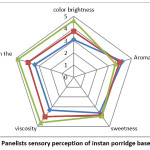 |
Figure 2: Panelists sensory perception of instan porridge based on F3 Click here to View figure |
Table 3 presents the analysis results of instant porridge that has been tested for its organoleptic, physical, chemical, and microbiological properties. The scoring index method was used to select the best product.
Table 3: Determination of the best product with scoring index method.
| Treatment | Properties | Level | ||||||||
| Organoleptic | Physical | Chemical | Microbiological | |||||||
| Color brightness | Aroma | Sweetness | Viscosity | Smoothness in the mouth | Rehydration capability (ml/g) | Solubility(%) | Protein content(%) | Total Plate Count (cfu/g) | ||
| A1B1 | 4.28 | 3.22 | 4.14 | 3.81 | 4.36 | 2.26 | 32.89 | 10.58 | 3.3 x 101 | 8 |
| A1B2 | 3.89 | 3.90 | 4.13 | 4.08 | 4.39 | 3.06 | 34.75 | 10.26 | 3.1 x 101 | 7 |
| A1B3 | 3.22 | 4.28 | 4.01 | 4.13 | 4.36 | 3.15 | 36.69 | 9.23 | 2.9 x 101 | 9 |
| A2B1 | 4,02 | 3.07 | 4.28 | 3.96 | 4.41 | 3.29 | 32.50 | 10.74 | 3.4 x 101 | 5 |
| A2B2 | 3.96 | 3.76 | 4.22 | 3.98 | 4.36 | 3.85 | 34.40 | 10.31 | 3.2 x 101 | 2 |
| A2B3 | 3.74 | 4.21 | 3.89 | 4.26 | 4.38 | 3.91 | 36.18 | 9.57 | 2.9 x 101 | 6 |
| A3B1 | 4.53 | 2.83 | 4.11 | 3.22 | 4.33 | 3.70 | 32.43 | 10.86 | 3.5 x 101 | 3 |
| A3B2 | 4.11 | 3.56 | 3.81 | 3.93 | 4.27 | 3.94 | 34.25 | 10.59 | 3.2 x 101 | 1 |
| A3B3 | 3.42 | 3.76 | 4.07 | 4.18 | 4.49 | 4.40 | 36.24 | 9.67 | 3.0 x 101 | 4 |
Note : A1B1 = water ratio of cooking 1:2 and pregelatination time was 2 minutes, A1B2 = water ratio of cooking 1:2 and pregelatination time was 4 minutes, A1B3 = water ratio of cooking 1:2 and pregelatination time was 6 minutes, A2B1 = water ratio of cooking 1:3 and pregelatination time was 2 minutes, A2B2 = water ratio of cooking 1:3 and pregelatination time was 4 minutes, A2B3 = water ratio of cooking 1:3 and pregelatination time was 6 minutes, A3B1 = water ratio of cooking 1:4 and pregelatination time was 2 minutes, A3B2 = water ratio of cooking 1:4 and pregelatination time was 4 minutes, A3B= water ratio of cooking 1:4 and pregelatination time was 6 minutes
The results showed that the best instant porridge using the index scoring method was the one with a ratio of ingredients to cooking water of 1:4, 4-minutes pregelatinization time, and organoleptic characteristics on a rating scale of 4 with “like slightly” criterion.
The ANOVA results of organoleptic test observation using a preference test (hedonic quality scale) on color brightness showed that the pregelatinization time and the interaction between the cooking water ratio and pregelatinization time had significant effects on the color of instant porridge, while the cooking water ratio had no significant effect on the color of instant porridge. The pregelatinization time had a significant effect on the aroma of instant porridge; thereby, the analysis then continued with Duncan’s test. The cooking water ratio and the interaction between the cooking water ratio and pregelatinization time did not show significant effects on the aroma of instant porridge.
The cooking water ratio, pregelatinization time, and the interaction between these two factors had no significant effect on the sweetness of the instant porridge. The cooking water ratio had no significant effect on the sweetness because water had a colorless, tasteless, and odorless nature under standard conditions.15 The water added was also in the form of free water (not bound to a substance or pure water). Free water can be easily lost if the evaporation or drying occurs.15 Thus, the ratio of cooking water — i.e., A1 (1:2), A2 (1:3), and A3 (1:4) — would not have a significant effect on the sweetness.
The cooking water ratio, pregelatinization time, and the interaction between these two factors had significant effects on the viscosity of the instant porridge. Therefore, Duncan’s test was performed to determine the effect of the interaction between these two factors. The cooking water ratio, pregelatinization time, and the interaction between these two factors had no significant effect on the smoothness of the instant porridge in the mouth.
The analysis of the characteristics of physical properties indicated that the rehydration capability of the instant porridge was 3.04 ml/g and the solubility was 34.25%. The high solubility of the instant porridge was caused by the use of drum dryers in the drying process. Drying the materials in the form of porridge using a drum dryer can increase the product’s solubility and water absorption.16
The results of the analysis using a scanning electron microscope (SEM) can be seen on Figure 3 for surface morphology, capsule size, specimen surface images, and physical form of the porridge can be associated with the increased solubility of the instant porridge prepared by pouring boiling water on it.
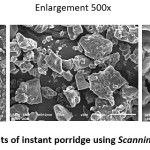 |
Figure 3: Analysis results of instant porridge using Scanning Electron Microscopy Click here to View figure |
The inulin-enriched porridge showed an evenly distributed, stable, and compact physical form because inulin had a high melting point; thereby, the inulin was resistant to the drum-drying process. The heating temperature in the drying process may cause the loss of active compounds, which makes the surface denser.17
The instant porridge contained 3.41% moisture, 1.65% ash, 76.03% carbohydrates, and 11.53% fat with an energy density of 450.25 kcal/100 g, a total plate count of 3.2×101 cfu/g, and Bifidobacterium longum of 169×10-6 cfu/g. The instant porridge met the Indonesian National Standards Number 01-7111.1-2005 for Complementary Foods in the Form of Instant Powder.18 The preference level was assessed by observing facial expression that used the 30 infants as the next panelists on a rating scale of 5.33 with “good” criterion.
The high protein content in the instant porridge was influenced by the addition of skim milk and tempeh flour as sources of protein. The optimal protein intake needs to be given to under-five children because it affects their growth and development. The Bifidobacterium longum content in the instant porridge was affected by the addition of inulin. Inulin and fructooligosaccharides (FOS) can significantly increase the growth of bifidobacteria, and they are useful for increasing calcium absorption.3 The addition of eight grams of inulin to the formulation of instant porridge as the complementary food for infants aged 6-24 months referred to the Food and Drug Administration (2003) stating that the use of inulin at 90% level was 6 g/day for infants under 12 months, 15 g/day for infants aged 13-24 months, and 20 g/day for infants over the age of 25 months.19 Complementary/supplementary foods that provides nutrient and prebiotic needs during infant weaning could improved growth outcomes and supported metabolism by the gut microbiota.20
The Effectiveness of the Product to Increase Calcium Absorption and Deposition in Rat’s Femur
The development of malnourished rat models referred to the results of a study conducted by Setyohadi et al., (2016) using Wistar albino rats aged 8-12 weeks with a weight of 100-200 g that received low-protein diet and normal diet interventions for 21 days.21 Anggraeny et al., (2016) used Wistar albino rats aged 4-5 weeks with a weight of 100-120 g that received low-protein diet intervention with various concentrations (0%, 2%, 4%, and 18% as a sufficient-protein diet) for two and four weeks.22 Lintang et al., (2016) conducted a study on Wistar rats aged 6-8 weeks with a weight of 150-200 g that received non-protein diet intervention for 56 days.23 Fifi and Eddy (2011) developed protein-energy malnourished (PEM) rat models using rats aged 5-6 weeks with a weight of 100-150 g that received a 56-d low-protein diet intervention for 56 days.24
The results of an analysis using SEM-EDXA showed an increase in the calcium absorption in the femur of rats receiving an instant porridge diet fortified with micronutrient premix and enriched with inulin. Calcium femur in malnourished rats were low compared than calcium femur in control group, but higher in inulin groups than groups without inulin. Malnutrition condition could cause developmental delays, stunted bone growth, and decreased bone mineral density.25 Figure 4 shows the condition of bone matrix in all five treatments. Figure 5 presents the composition of macromineral constituents in the femur. The radiographic examination of the femur of the rats was performed to analyze the density or strength of bone mass. The solid bone will show a more radiopaque image while the less solid bone will show a more radiolucent result.26
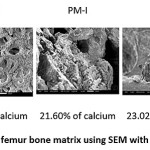 |
Figure 4: Condition femur bone matrix using SEM with enlargement 1000x Click here to View figure |
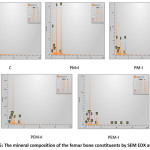 |
Figure 5: The mineral composition of the femur bone constituents by SEM EDX analysis Click here to View figure |
Inulin in the porridge can function as a prebiotic, which is expected to support the health of under-five children because it plays a role in increasing calcium absorption. The hypothetical mechanisms of increased calcium absorption after consuming inulin-type fructans were as follows: (1) an increase in water content in the large intestine that affected osmotic pressure; (2) a decrease in intestinal pH to be acidic due to the effect of lactic acid bacteria fermentation that produced short-chain fatty acids (SCFAs); (3) an increase in solubility of calcium in the small intestine due to the presence of SCFAs; (4) an increase in absorption surface area due to mucosal hypertrophy; and (5) an increase in butyrate production that could stimulate vitamin D to increase calbindin that had a positive correlation with increased calcium absorption.3
Calcium retention in the femur is affected by individual diversity, adequacy of vitamin D, and the role of magnesium in calcium absorption in the bones. Bones play a role in metabolic function by providing a source of calcium to maintain the balance of calcium levels in the blood and transforming growth factor-beta (TGF-β), which play a role in bone remodeling.27 Bone formation involves osteoblasts as the main cells producing bone matrix. Osteoblasts regulate calcium ion concentrations in the matrix through the release of intracellular calcium.28 Bone quality improvement was characterized by increased bone calcium levels, bone density, and bone strength.29 According to Wimalawansa (2004), calcium intake had a positive correlation with bone density.30 The femur used for the analysis was the calcium deposit. Eastwood (1997) suggested that calcium was generally stored in the skeleton.31
Bone mineral is an inorganic form of bone, and its main compounds are calcium phosphate crystals or calcium hydroxyapatite crystals [3Ca3(PO4)2Ca(OH)2]. The main composition of bone mineral consists of calcium and phosphorus. The bone mineral also consists of sodium, potassium, magnesium, fluoride, carbonate, and hydrogen.32 The results of this study showed that the ratio of calcium to phosphorus in the rat’s femur was between 1.88 and 2.23. The ratio of calcium to phosphorus in the rat’s femur was still in the normal range.
Calcium that is absorbed will mostly be used to structure bone. During pregnancy, maternal calcium homeostasis adapts to meet the calcium demands of the growing fetus, and it can influenced bone growth in the next stage of life.33 In infancy, physical growth develops rapidly, accompanied by gradual bone growth and skeletal maturation.34 When bones begin to form, calcium salts form crystals, called hydroxyapatite, in the collagen matrix of proteins. During mineralization, crystals become denser, this makes the bones become stiff and strong.35
Conclusions
The best porridge for complementary feeding based on the scoring method was the one with A3B2 treatment. The results of the analysis showed that the characteristics of the porridge met the quality requirements for complementary foods in the form of instant powder, according to Indonesian National Standards Number 01-7111.1-2005. The results of right femur examination using SEM showed the deposition of calcium content in the femur of the rats in the C (37.85%), PM+I (28.02%), PM-I (21.60%), PEM+I (23.02%), and PEM-I (21.29%) groups. These results indicated an increase in calcium absorption with the high calcium levels in the rat’s femurs and more solid bone matrix conditions in the protein-malnourished (PM) and PEM rats receiving inulin-enriched instant porridge than the femur of the PM and PEM rats receiving instant porridge diet without inulin enrichment.
The complementary food products based on local resources are expected to contribute to national problem solving, namely reducing the stunting rate in Indonesia.
Recommendations
- This study needs to be continued with clinical analysis of stunted under-five children.
- The involvement of entrepreneurs is needed, as the beneficiaries of the results of technology that can produce this product continuously by utilizing the potential of local resources.
Acknowledgement
The author thanks to the Research Center for Appropriate Technology-Indonesian Institute of Sciences and Community Nutrition Study Program-IPB University, for the laboratory team and facilities to conduct this research.
Funding Sources
This research was funded by the Ministry of Research, Technology and Higher Education of the Republic of Indonesia (INSINAS 2019).
Conflic of Interest
All authors declare no conflict of interest.
References
- Subagio A. Prosedur Operasi Standar (POS) Produksi Mocal Berbasis Klaster: Rusnas Diversifikasi Pangan Pokok. Southeast Asian Food and Agricultural Science and Technology Center, Institut Pertanian Bogor; 2008. https://books.google.co.id/books?id=oWfIZwEACAAJ.
- Sugiyono, Pratiwi R, Faridah N. Modifikasi Pati Garut (Marantha arundinacea) dengan Perlakuan Siklus Pemanasan Suhu Tinggi-Pendinginan (ACC) untuk Meng-hasilkan Pati Resisten Tipe III. J Teknol dan Ind Pangan. 2009; XX(1): 17-24.
- Roberfroid MB. Introducing inulin-type fructans. Br J Nutr. 2005; 93(S1): S13-S25. doi:10.1079/bjn20041350.
- van den Heuvel EGHM, Schoterman MHC, Muijs T. Transgalactooligosaccharides Stimulate Calcium Absorption in Postmenopausal Women. J Nutr. 2000; 130(12): 2938-2942. doi:10.1093/jn/130.12.2938.
- Kennefick KD, Cashman Investigation of an in vitro model for predicting the effect of food components on calcium availability from meals. Int J Food Sci Nutr. 2000; 51(1): 45-54. doi:10.1080/096374800100895.
- Tampubolon NL, Karo-karo T, Ridwansyah. Formulasi Bubur bayi Instan dengan Substitusi Tepung Tempe dan Tepung Labu Kuning Sebagai Alternatif Makanan Pendamping ASI (Formulations of Instant Baby Porridge with Tempeh Flour and Pumpkin Flour Substitution as an Alternative Complementary Breast). J Rekayasa Pangan dan Pertanian. 2014; 2(2): 78-83.
- Mirdhayati I. Formulasi dan Karakterisasi Sifat – Sifat Fungsional Bubur Garut (Maranta Arundinaceae Linn) lnstan Sebagai Makanan Pendamping Air Susu Ibu (MP-ASI). 2004. https://repository.ipb.ac.id/handle/123456789/7809.
- Rasper VF, DeMan JM. Effect of granule size of substituted starches on the rheological character of composite doughs. Cereal Chem. 1980; 57(5): 331-340.
- Goldstein JI, Newbury DE, Echlin P, et al., Scanning Electron Microscopy and X-Ray Microanalysis. Boston, MA: Springer US; 1992. doi:10.1007/978-1-4613-0491-3.
- Badan Standardisasi Nasional. 1992. Indonesian National Standards Number 01-2891-1992 regarding How to Test Food and Beverage.
- Soekarto S.T., Hubeis M. Metodologi Penelitian Organoleptik. Bogor: Institut Pertanian Bogor; 199
- Guinard J-X. Sensory and Consumer Smiley Face Testing With Children. Trends Food Sci Technol. 2001; 11:273-283.
- [AOAC] Association of Official Analytical Chemistry. Official Methods of Analysis. (Horwitz W, ed.). Maryland: AOAC International; 2005.
- Akpoué NA, Kouamé KG, Zoho BFGA, Essé SE, Yéboué KH, Amoikon KE. 2018. Efficiency of balanced and fortified diet on growth and values of serum Parameters in young rat protein deficiency. 2018; 10(9): 73545-73551.
- Purnomo H. Aktifitas Air Dan Peranannya Dalam Pengawetan Pangan. Jakarta: UI Press; 1995.
- Tang J, Hao F, Guo-Qi S. Drum Drying. In: Encyclopaedia of Agricultural, Food, and Biological Engineering. New York: Marcel Dekker Inc; 2003: 211-214.
- Deladino L, Anbinder PS, Navarro AS, Martino MN. Encapsulation of natural antioxidants extracted from Ilex paraguariensis. Carbohydr Polym. 2008; 71 iss.
- Badan Standardisasi Nasional. 2005. Indonesian National Standards Number 01-7111.1-2005 regarding Complementary Foods in the Form of Instant Powder.
- Food Standards Australia New Zealand. Addition of GOS, Long Chain Inulin to Infant Formula Products & Infant Food.; 2007. http://www.foodstandards.gov.au/standardsdevelopment/.
- Zambrana LE, McKeen S, Ibrahim H, et al., Rice bran supplementation modulates growth, microbiota and metabolome in weaning infants: a clinical trial in Nicaragua and Mali. Sci Rep. 2019; 9(1):1-18. doi:10.1038/s41598-019-50344-4.
- Setyohadi, Permaningtyas TK, Putri RA. Effect of Winged Bean ( Psophocarpus tetragonolobus L.) Seed Flour Substitutions towards Protein Serum Level in Rat with Low Protein Diet. Maj Kesehat FKUB. 2016; 3(2): 86-92.
- Anggraeny O, Dianovita C, Nurina Putri E, Sastrina M, Setya Dewi R. Korelasi Pemberian Diet Rendah Protein Terhadap Status Protein, Imunitas, Hemoglobin, dan Nafsu Makan Tikus Wistar Jantan (The Correlation of Low Protein Diet Administration on Status of Protein, Immunity, Hemoglobin, and Appetite of Male Wistar Rats Ratt. Indones J Hum Nutr. 2016; 3(2): 105-122. doi:10.21776/ub.ijhn.2016.003.02.6.
- Lintang Purwara Dewanti, Aris Widodo EF. Pengaruh Pemberian Tepung Daun Kelor terhadap Kadar Albumin Darah Tikus Wistar yang Diberi Diet Non Protein. J Gizi Kesehat. 2016; 1(1): 23-39
- Luthfiyah F, Widjajanto E, Mataram PK, et al., Serbuk Daun Kelor Memulihkan Kondisi Fisik Gizi Buruk pada Tikus Model Kurang Energi Protein The Effect of Leaves Powder Moringa Oleifera in Physical Recovery of Protein Energy Malnutrition Rat Model. 26(3): 131-135.
- Kueper J, Beyth S, Liebergall M, Kaplan L, Schroeder JE. Evidence for the adverse effect of starvation on bone quality: A review of the literature. Int J Endocrinol. 2015. doi:10.1155/2015/628740.
- Sabri M. Aktivitas ekstrak etanol batang sipatah-patah (Cissus quadrangula salisb) sebagai antiosteoporosis pada tikus (Rattus norvegicus). 2013. Dissertation. School of Post Graduate. Bogor Agricultural University.
- Dellman H, Eurell J. Veterinary Histology. 7th ed. America (US): Lippincott Williams and Wilkins; 1998.
- Guyton AC, Hall JE. Fisiologi Manusia Dan Mekanisme Penyakit (Human Physiology and Mechanism of Disease). 3rd ed. Jakarta: Kedokteran EGC; 1996.
- Safrida NK, Manalu W, Maheshwari H. The decreased serum progesterone concentrations and extracellular matrix and cellular components of skin as indicators of aging in rats. J Kedokt Hewan. 2013; 7(1): 13-16.
- Wimalawansa S. Relationship of calcium, vitamin D, and other nutrients to bone health. Bussines Brief Women Healthc. 2004: 1-11.
- Eastwood M. Principles of Human Nutrition. Boston, MA: Springer US; 1997. doi:10.1007/978-1-4899-3025-5.
- Hernndez-Urbiola M, L. A, Jimenez-Mendoza D, et al., Mineral Content and Physicochemical Properties in Female Rats Bone During Growing Stage. In: Atomic Absorption Spectroscopy. InTech; 2012. doi:10.5772/25484
- Naylor KE, Iqbal P, Fledelius C, Fraser RB, Eastell R. The effect of pregnancy on bone density and bone turnover. J Bone Miner Res. 2000; 15(1):129-137. doi:10.1359/jbmr.2000.15.1.129
- Theobald H. Dietary calcium and health. Nutr Bull. 2005; 30(3): 237-277. doi:10.1111/j.1467-3010.2005.00514.x
- Whitney EN, Rolfes SR. Understanding Nutrition. Belmont: Wadsworth Cengage Learning; 2015.

This work is licensed under a Creative Commons Attribution 4.0 International License.






